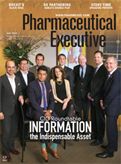- Sustainability
- DE&I
- Pandemic
- Finance
- Legal
- Technology
- Regulatory
- Global
- Pricing
- Strategy
- R&D/Clinical Trials
- Opinion
- Executive Roundtable
- Sales & Marketing
- Executive Profiles
- Leadership
- Market Access
- Patient Engagement
- Supply Chain
- Industry Trends
Transforming Technology: The Future of the CIO in the Life Sciences
Pharm Exec convenes a roundtable discussion with several company chief information officers (CIOs) and IMS Health to explore ways to turn the vast reams of data now being generated in the transactional tsunami of modern healthcare into truly meaningful insights for its users.
Information is the coin of the realm in biopharmaceuticals-but what will it take to make the vast reams of data now being generated in the transactional tsunami of modern healthcare truly useful to its users? To help answer this question, Pharm Exec recently hosted an editorial Roundtable with several
Photo: John Halpern, Le Bernardin Restaurant
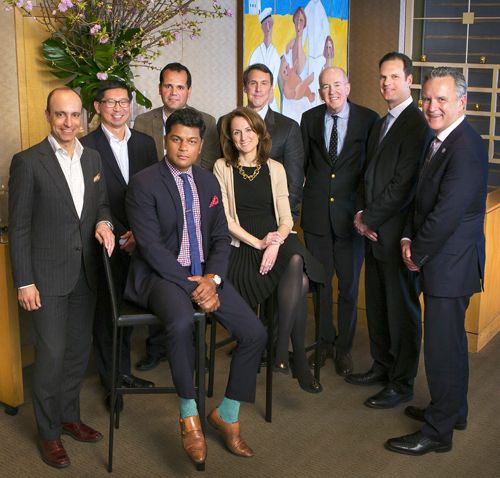
company chief information officers (CIOs) and IMS Health, whose Institute for Healthcare Informatics, together with the Egon-Zehnder executive search firm, recently issued a report on how the CIO role must transform to make the “c-suite” cut as a key driver of internal innovation. The following are excerpts from the discussion-in the plain English CEOs prefer, no algorithms
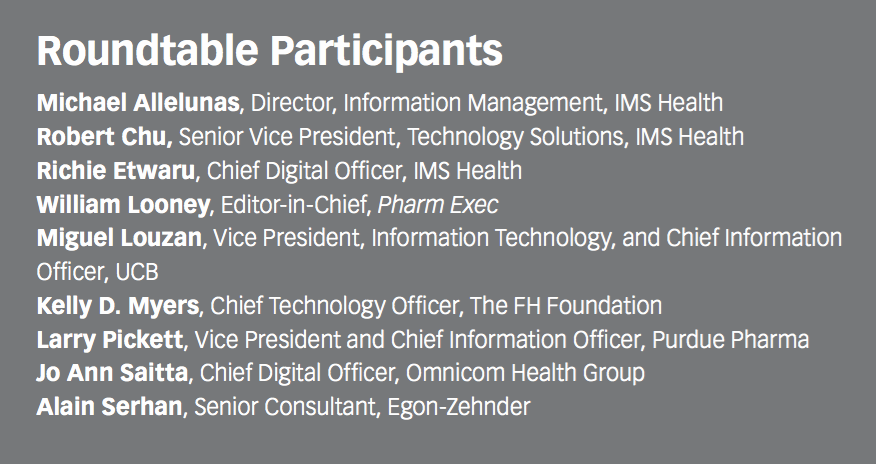
required.
William Looney, Pharm Exec: A single word defines today’s life science industry. That word is “disruption.” And the single biggest driver of this disruption is information. Information and the analytical capabilities that come with it has enabled a major shift in the industry’s business model, from a transactional approach-selling a pill-to an outcomes approach where that pill is only one part of the patient experience. Can we describe and agree on the basic contours of this disruption as it relates to the role of one of the newest entries to the c -suite: the chief information officer (CIO)? More directly, is today’s CIO poised to be a specialist-or a strategist?
Richie Etwaru, IMS Health: Recently, I was asked how we should respond to the ways that information technology is transforming the financing, delivery and marketing of healthcare. I said that before we could advise clients on how to build and execute a strategy focused on new technology solutions, you first had to understand what a transformed business model might look like. That’s why the IMS Institute and partner Egon-Zehnder, in a joint report released last month, New Strategic Information and Technology Roles in Life Sciences Companies, came up with a metric called the Information Technology and Transformation Scoring (ITTS) framework. ITTS is designed to help companies assess their progress in meeting customer expectations in five key areas. These are, on the strategy side, Innovation and Disruption and Organizational Transformation, and, on the operations side, Big Data and Analytics, Technology Infrastructure, and the Future of Work.
Why is it necessary for the industry to align to this new model? We see three factors, each induced by larger environmental trends shaping the IT world. The first is “exponentiality,” or the rapid compression of the time in which innovations enter markets to displace existing products and services. The trend explains why the life span of any product can now be measured in years or even months, not in decades. It demands that companies keep their gaze firmly on the future, actively studying where the next wave of life sciences products and services is coming from.
One way to do this is to focus on your supply chain. It has to be compressed, with most of the non-essential elements contracted out. The areas where supply chain management really counts today are product design; process engineering; and the overall “ownership experience” of the customer. This latter point is often seen as something intangible, but in fact it is an increasingly critical marker of competitive differentiation now that virtually anyone in the business can intervene with products or services that add value to the producer’s original market proposition.
The second reason is the nature of innovation, expressed as a platform that can be pursued in two ways: “evolutionary” innovation and “revolutionary” innovation. Most big pharma organizations remain firmly in the evolutionary camp, where it’s okay for a few projects to fail while a few others succeed, while start-up operations often have little choice but to hedge their entire future around a single bet. When that single bet leads to an approved product you are a hero. So the level of risk to practice evolutionary innovation or revolutionary innovation depends on where you sit. Today’s R&D imperative to “fail fast and early” means different things to big Pharma compared to a start-up operation.
The third reason is “disruption,” which we separate into three components: product disruption; process disruption; and experience disruption. Again, we believe this latter element-related to the customer experience-is a critical driver of transformation. An example is Uber, which has grabbed market share from the taxi business by elevating that experience to remove what was ugly about the traditional taxi, especially the confusion and inconsistency around the payment model-fare per mile? Cash or credit? Tipping? The Uber platform, which surprisingly does not require the expense of operating a fleet of vehicles, has turned out to be a massive disrupting technology because its operating model conforms to all three of these factors-product disruption, process disruption and experience disruption-driving market change.
Looney: In practical terms, how will this transformational change shape the future of the healthcare and pharmaceuticals market? Uber is revolutionizing the business of personal transportation without owning any automobiles, while Airbnb is the world’s largest private hoteling business but owns not a single room. Extending the concept, does this mean a company can succeed in biopharmaceuticals without developing a medicine?
Kelly D. Myers, FH Foundation: As the sophistication of information technologies progress, we will witness a democratization of insights, where individuals will be able to better understand and interpret their own health data, motivating the patient to do the right thing for his/her health. If an individual understands the risk/benefit of every decision they make and how it impacts their health, they will be equipped to make better choices.
There are significant business opportunities here, premised on manufacturers innovating “beyond the pill.” Biopharmaceutical companies can expand their service orientation, this time geared to the information needs of the patient rather than just the healthcare provider. Those who commit to this type of ”patient centricity” will thrive through a process innovation that can be just as important to delivering positive health outcomes as a new drug.
Larry Pickett, Purdue Pharma: Disruption is also coming as the health system gets better at collecting, storing and sharing this data. If patients take ownership of their information, it suggests they will also be more selective about sharing it. Companies and vendors will create new businesses to pull all these disparate streams of information together and render it coherent as real world evidence to different stakeholders. For example, with the appropriate regulatory oversight, clinical trials of the future could be conducted entirely through the internet, a development that by itself will be disruptive.
Etwaru: Uber has created a new marker of market success, where the customer experience is more important than the brand-in fact, the experience is the brand. This carries important implications for the biopharmaceuticals business, because we all know that in our sector the opposite is the case: the brand may be touted as a scientific breakthrough but the actual customer experience in accessing it is roundly criticized by nearly everyone. The industry is filled with product people, yet increasingly today that customer experience-the process-is the instrument by which the industry reputation is measured.
Myers: If the biopharma enterprise can solve the equation calling for the right pill, at the right time, for the right patient, then that’s a formidable process innovation. We need to focus on the “ideal” patient. Companies need this focus because there are still too many misses in attempting to match these three mandates to broad patient populations.
Miguel Louzan, UCB: We spend a great amount of time talking to patients, payers and other stakeholders about the details of access, drug benefit design and reimbursement criteria. This is another hurdle that hurts the industry-and it is partially due to process. Stakeholders respect our medicines. We all want to engage productively as partners but there is this lack of clarity on how to navigate through the complexity of the healthcare system.
UCB is devoting significant resources to helping our customers manage these channels. Technology and data must be leveraged to the point that these investments to help us to prevail on the commercial side are beginning to approach the cost of securing registration approval.
Looney: We have a consensus that innovations on the process side can raise the quality of the overall customer experience, the perceptions of which are critical to maintaining a biopharmaceutical company’s edge against the competition. Can you describe how your CIO function contributes to this objective-what are the challenges in advancing the c-suite CIO’s transition from a technical back office function to a strategic asset? And what is the difference between IT strategy and digital strategy-is it just a word play?
Louzan: At UCB, I lead the application of technologies to drive our commercial business objectives with customers like payers as well as the connected patient communities representing those with immunologic and neurologic disorders that drive our key therapeutic franchises. Digital information is an important element here; we go beyond the drug itself by investing in wearables and apps that help patients with a complement to their therapy as well as in data analytics to support the needs of payers, insurers and physicians.
We don’t decide what digital technologies should be incorporated into the promotion launch and execution cycles of each brand; that is the responsibility of the brand’s teams. What we do is take a step back and help our commercial teams figure out how a digital or information technology might help them meet their P&L objectives.
Looney: Are there limitations to using digital technology as part of a commercialization strategy?
Louzan: Of course. My background is in medical devices, where we know that good data can be obtained with relative ease because the process takes place around a single transaction. Pharmaceuticals are different. There are many touchpoints.
What we hear directly from customers and patients does not always conform to the information we obtain from market research. It is harder to measure just how much a digital intervention contributes to a superior business result. Again, the proof is ultimately how information technology, as applied, contributes to a better customer experience with the product.
Looney: How else is the overall market environment shaping the mandate for the CIO?
Pickett: In my company, the role of CIO has evolved. What was once a position that managed those back-office systems around prosaic things like inventory control or accounting and payroll is now more closely tied to the actual business of developing and selling product. It is all about deploying information as an asset with a direct P&L orientation. In this case, we see less of a role for a chief digital officer because digital can no longer be separated out but instead incorporated within each discipline under this broader strategic mandate.
Jo Ann Saitta, Omnicom Health Group: In our experience, we see the CIO position as focused on internal strategies and operations, while the chief digital officer (CDO) is directed toward the external environment, with an emphasis on creating better ways for the company to communicate and interact with customers and other influentials. It’s a service role with an emphasis on innovation in getting your messaging to stand out.
Pickett: The distinction between the internal and external is interesting. Purdue has a new CEO, Mark Timney, who joined us from Merck & Co. Under the previous regime, IT was an inside operation geared to making the trains run on time-standard operating procedure was the overriding goal. And the benchmark was also internal, in the sense that we graded ourselves against our competitors in pharma.
Timney immediately took us to another step, asking how Purdue compared to Apple in terms of our user interface experience. Or could we match Amazon in our distribution
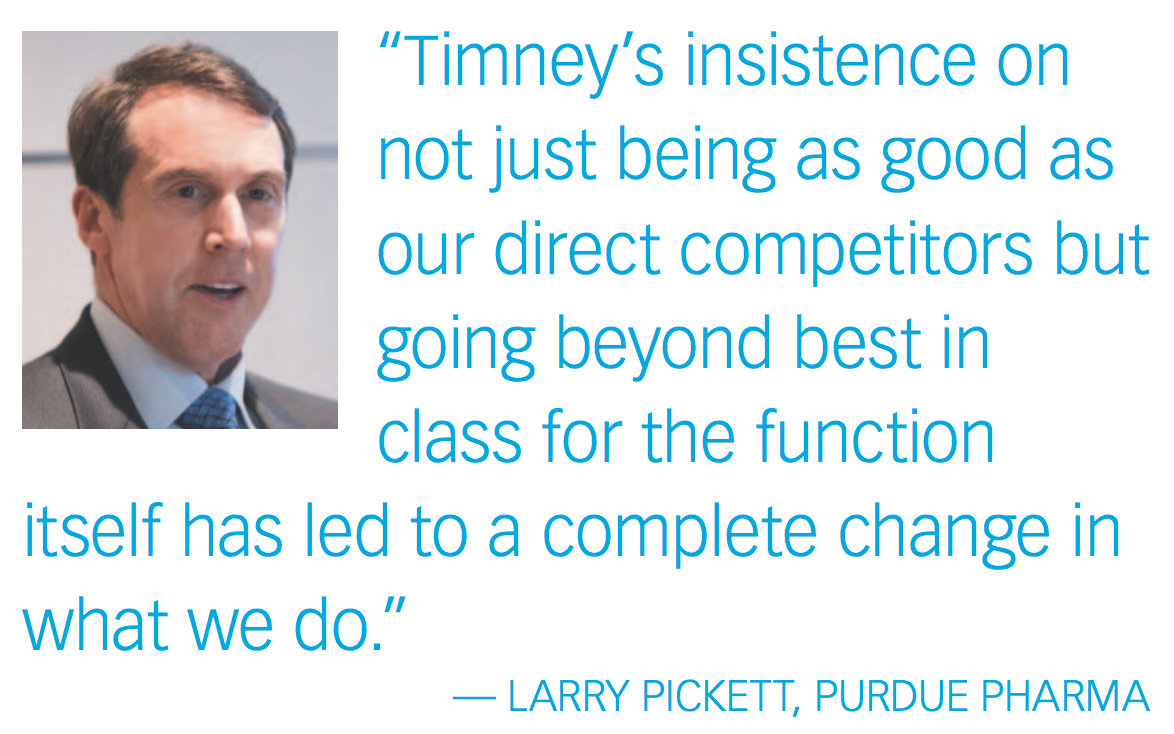
and inventory management? His point: If Purdue expected to keep connecting to customers and patients, we had to up our game and strive to match the performance of outsiders who were actively disrupting the model of the businesses they were in.
Timney’s insistence on not just being as good as our competitors but going beyond best in class for the function itself has led to a complete change in what we do-not only are we strategic, we are forward looking and actively seeking to leverage external ideas, constantly looking at precedents that on the surface have little to do with our industry but could be completely disruptive to our business if we fail to see these coming.
Alain Serhan, Egon-Zehnder: The CIO role is at the center of a discussion taking place in every large business, which is how best to seed a culture of innovation within the organization. One approach is endowing an internal group with a separate line of sight on key strategic challenges-a way to avoid being caught up in the standard operating procedures that tend to quell the creativity, initiative and risk required in trying something new.
Another is when the CEO decides a new position is necessary to stretch or test existing organizational boundaries. An example is “chief innovation officer” or, yes, the “chief digital officer.” Often, however, persons in these roles quickly experience what I refer to as institutional organ rejection, where they find it is literally impossible to integrate with support from others in the senior management team. Resistance can be particularly stiff in biopharmaceuticals due to the innate conservatism of business practices that limit the freedom to operate -the IP system is but one example. New drug technologies have to be proven safe and effective beyond a shadow of a doubt and then they have to be protected. This can put a damper on the entrepreneurial mindset.
Over time, however, I believe organizations do adjust to the reality that market change imposes on them. One thing I hear from the discussion today is the CDO is a stop gap. A decade from now, I expect that position will no longer exist. We just won’t be talking about digital health. Every corporate function will have mastered the discipline. It will be considered part of health because the technology to do it is so embedded in the healthcare system. Remember those VC funds in the 1990s with a special purpose to invest in mobile-related ventures? Today, these funds can no longer segregate this area of investment because mobile is a ubiquitous technology; it is now, by definition, everywhere.
Louzan: The same is true for social media. It too is embedded in the overall construct of “information.” It will be seen as but one more channel in the data/information platform from which we can derive insights for our product marketing.
Etwaru: We need to understand that it is good that positions within large organizations will ebb and flow in tandem with the pace of market change. It is a prism by which we can see whether our organizations are going to be ready for the next generation of clients and customers. Three years ago, if we described the background of a new CDO, it would turn out that most came from media or advertising. That made sense, as the role was seen largely as a listening post and entrée to the murky world of social media. Now the role is all about contributing to the product franchise P&L while defining and co-creating the next generation of products that will also drive P&L. Digital is just one of many marketing channels.
Myers: One way to better define the position of the CIO or the CDO is to embrace what Richie Etwaru calls “cruciality.” It’s all about centering the function around what’s truly important to the organization. Katherine Wilemon is the founder and leads the FH Foundation, a research and patient advocacy group for a deadly, little known condition called familial hypercholesterolemia (FH).
An estimated 1.3 million people in the US suffer from this condition, which is genetic in origin, is readily diagnosable and treatable, yet if left untreated can lead to a 50/50 chance of suffering a heart attack by age 50. We estimate that 90 to 99% of patients with the condition are unaware they have it, so the goal of our FH Foundation is get individuals as young as 10 signed up for a preventive screening and treatment that manages this risk.
Led by Katherine’s vision, we created a machine learning algorithm to identify the number of probable FH individuals (those with medical and insurance records consistent with FH) at the provider level to encourage early screening and diagnosis and initiate preventive treatment. I serve as the Foundation’s chief technology officer (CTO), and I found that what helped us achieve this goal was actually the lack of any existing analytics infrastructure that might have seen this initiative as a disruptive threat.
It’s ironic: we had no technology infrastructure in place and yet we secured our objective earlier and identified probable FH patients than had we had legacy IT systems to deal with. It is something large organizations should take to heart. In trying something new, you have to account for the burden of replacing what’s already in place. I think that’s an important part of the CIO role that we have not discussed.
Pickett: The trend today in IT is to rely on the “incubator” approach to tackle those big change issues, effectively removing the process to a place outside the larger organization. But there is an alternative, which is to leverage external partnerships. At Purdue, we are pursuing this in a structured way by exploring partnering with academic centers, hospitals and other institutions vital to our business. It’s a “supply chain of knowledge” where we approach partners for their ability to offer answers to challenges we can’t solve on our own.
Looney: With reference to the priorities of today’s CIO, which would you identify as most critical? One item that comes up frequently is finding a path around those big strategy questions-such as, is the mission of the organization to share information or to protect it?
Louzan: This is hard to separate; the mission of the CIO must be to do both. UCB has to be sensitive to protecting information, particularly patient data, from disclosure that violates legislated guarantees of privacy. We are held in a position of trust that we will do the right thing for patients with the data we collect. At the same time, we have an
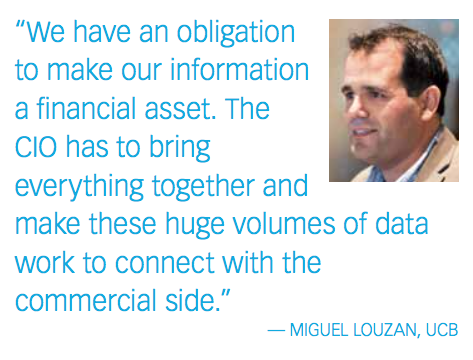
obligation to make our information a financial asset, with insights that can drive the market for our medicines. The CIO has to bring everything together and make these huge volumes of data work to connect with the commercial side. If you don’t invest in that, you will lag the competition.
Pickett: This is a question that has no precise answer. It is impossible for us to “own” all the data we compile. Some of it we actually purchase from outside vendors. There is also a massive increase in the availability of public data from the government, where CMS has made a commitment to make this flow open and available to anyone. Our industry contributes to that-pharmacovigilance stats are a prominent example-but we don’t own or control it.
The priority in this for the CIO is to develop novel-I mean useful-ways to integrate these data streams so that management can make wise, forward-looking decisions to grow the business. Information in biopharmaceuticals is the ultimate ecosystem. And this ecosystem is increasingly centered on the goal of creating more value for industry stakeholders while improving outcomes. Information must be harnessed to do one thing: improve patient care and, in doing so, deliver a better outcome for the health system.
Last year I took the initiative to establish a team to explore the “patient journey” of those using Purdue’s medicines. The objective was, by better understanding how the patient and their caregivers think about pain, we could investigate ways to apply IT and data sets to promote improved patient outcomes.
Louzan: Another, related priority for the IT team is contending with the dilemma of leveraging the data for the business when we don’t know much about that data, or that we don’t control it. An example is making sense of the significant information we are now getting about the patient experience outside the drug setting, such as quality-of-life indices, where it can be said the average patient suffers the most loss.
Can we find a means to embed this kind of data into the R&D or clinical trial process so that it benefits product design and strategy at that critical early stage of development?
Saitta: It’s all about the interoperability of data systems and the liquidity of the information flow, with the ultimate aim of connecting the dots to get good insights. In the latter case, I believe it’s important to adjust the focus from the abstract idea of the patient to the person.
I spend a lot of time talking to commercial teams about a change of mindset, which I reference as “treat the person, not the patient.” How do we do that? An example is directing more of your advocacy investment to the caregiver, whether it is a spouse or children, because it is this group who really know if the patient is taking the medication or not.
Etwaru: Some 80% of the value that information can produce already exists from what is already on hand within the organization.
Louzan: That’s true. We have vast stores of data collected through clinical trials, R&D science, and now from social media. This has already been said, but the problem lies in accessing and then assessing it.
Our industry needs to be more innovative; it is hard to break with the old approaches where we limited our range to data that we knew how to handle, using time-honored standards of practice structured on the registration requirements of the regulator. So when someone says let’s start looking at the data from another angle, such as combining data types that have historically not been combined, it raises a red flag. But I think that attitude is fading. It’s only a matter of time, because regulators, payers and patients are demanding it.
Serhan:As CIOs and CDOs, do you feel that your objectives-on both the information and digital fronts -are aligned around those of the larger organization? Is there a consensus among your peers that what you do fits the requirements of a changing biopharma marketplace?
Pickett: At the initiative of our new CEO, Purdue for the first time has IT objectives embedded in our overall corporate strategy and operating plan. We are committed to the use and understanding of technology and data from a strategic perspective. So we feel we are getting more aligned. I am also being challenged to reach out to customers and patients. There is less emphasis on back-end IT operations, which are now seen as largely self-sustaining-Microsoft can manage our email and outsourcing firms can handle managed infrastructure services.
That’s a big shift from the time I was interviewed at Purdue nearly two decades ago, asked to weigh in on questions like encryption technology and the best desktop standard. No one at my level is talking about that today. The salient theme is designing a distinctive, stand-out digital strategy. Demonstrating how to use data to improve the patient experience and connect to the customer. It’s actually the same things other industries like consumer goods are figuring out-how information assets can lead to better decisions for customers and ultimately the business.
Recently, I participated in a peer group meeting with 20 other biopharma CIOs. We were each asked to share our view on what really matters to the function going forward. Technology itself got zero votes. Top of mind was finding strategic third parties to help develop and implement big data analytic strategies.
We are also on the cusp of a new business role involving data science. Instead of data scientists, this role is embedded in the business. Many who have come up through the IT ranks are systems administrators rather than business analysts. Yes, the trains still have to run on time but that’s just the table stakes. We and most everyone else in IT are developing talent for an entirely different set of capabilities.
Looney: What about the chief digital officer role? How is that changing?
Saitta: I would describe it as moving toward the in-house equivalent of Amazon. It is using the customized audience development tools enabled through digital to help the commercial teams broaden their perspective on the customer and finding new ways to
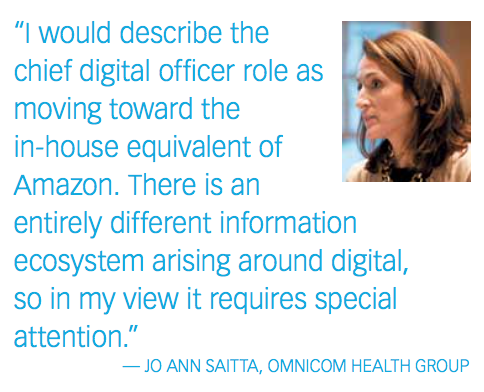
understand and serve patients. There is an entirely different information ecosystem arising around digital, so in my view it requires special attention.
Looney: What specifically are your clients asking you to help them to do on digital?
Saitta: They want advice on how to execute a program around information innovation. We help them consider an internal project or program that will bring the concept of innovation to life. Another is to build more expertise in predictive analytics, with emphasis on teasing out those leading and lagging indicators around marketing success. What framework on messaging to physicians, payers and patients might yield the best results?
A third area of interest is creating the technology that track consumer interests and preferences, just like what happens with those reminder messages after Amazon observes you scrolling its site for shoes. Programmatic software like that doesn’t exist right now in healthcare.
Finally, many clients have been operating in the digital space for a decade and want to “clean house.” There is a lot of internal clutter as departmental websites proliferate and product apps number in the hundreds, along with endless visual aids tailored to individual brands. How do we replace the chaos with order and make all of this connect?
Etwaru: Clients want to engineer a shift from rich media to relevant media. This is a vital issue to address if advertisers are to justify their role going forward. Ninety percent of the videos posted on YouTube are viewed by less than 50 people; the same is true for blogs on the Internet. You are paying for something that delivers little access because it is not relevant.
Louzan: At my most recent interaction with UCB’s commercial leadership, two questions came up. One was on how many interactions we have directly with patients through digital channels. The other was a request from one of our senior executives who was visiting a European country and wanted a recap of what patients were saying about the company’s therapies through digital. I thought it significant that it was not the standard question about the ratio of sales to investment or other issues linked to budgets. To me, it demonstrates that digital is capable of finding its own internal audience, one that appreciates the insights that come from access to the world outside the factory gate.
Of course, there is a necessary growth curve. I was not entirely happy with the sum total of digital interactions in that country compared to traditional means of contact, but it takes time to cultivate the audience.
Serhan: What concerns me is whether the CIO/IT community is prepared to address a larger existential threat to the industry. We have talked today about the customer experience as a driving force for change that has to be measured if biopharma companies

are to remain viable competitors-but what if the best provider of that customer experience comes from outside the industry? There is the risk of an entire industry being disintermediated by a Samsung or a Google. Is the CIO prepared to address this threat and fight it through better understanding of that customer experience?
Louzan: Certainly I see it as part of my job to bring this intermediation issue to light. Samsung, many CROs and of course “the” Google likely have tremendous insight about our patients and customers. We must do a better job at monitoring the patient experience, turning our data into actionable insights to increase the quality of our engagement, or we will discover these non-traditional competitors have literally changed the market.
Saitta: Within the decade, the largest healthcare organization may be one with a background in the tech business. Google could become the broker of that superior customer experience.
Etwaru: Why not the big pharmacy chains? There are 70,000 pharmacies in the US alone and all are well trafficked by patients. Will Walgreens surpass big Pharma in the customer experience because it can provide the drug along with supplemental support to help raise adherence, pass along cost savings from rebates, and offer a free scan for
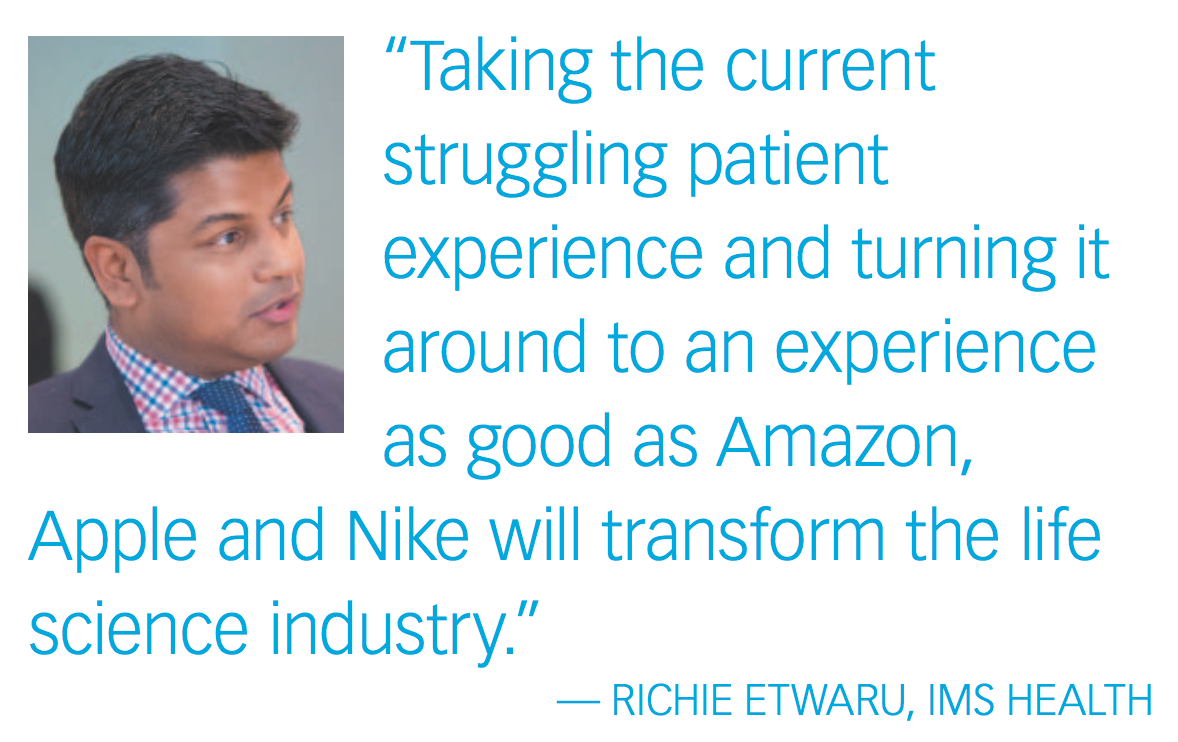
high blood pressure too? Patients are being conditioned in other industries with great consumer experiences, at companies like Amazon, Apple and Nike. Here, they are not patients; just people. This expectation of a “great experience” is being called for today in the life sciences. A company that takes the current struggling patient experience and turns it around to an experience that is as good as that of these three iconic brands will transform the life sciences industry. A large part of this transformed experience will be digital; hence, the important anchoring role of the CDO.
Looney: Aside from the challenge of disintermediation, what do you see as the impact of technology on the business of information? Is technological progress potentially outpacing your ability to cope?
Pickett: There is a proliferation of data coming from every direction-wearables are just one new source. The value is balanced against the difficulty of aggregating data from disparate data sources, including this new inflow, to derive real meaning from it. All these sensor and wearable “passive data collectors” will be ubiquitous. They will be embedded in your clothes, eyewear, and in your home and car. Data will be collected constantly and sent to some kind of health portal, to be aggregated in your individualized electronic health record. All of it can be transferable to the Cloud, to be viewed by multiple health providers regardless of the source of data or your location.
The big question is how all this will work in practice. Many in the industry are talking about how to collect patient data and apply it in the clinic in the form of real-world evidence. I am convinced that the wave of the future is more about passive use of technology and data collection than active use.
Myers: The computation challenge is mind-boggling. If you look at the information embedded in the human body, we have not even begun to discover how big big data can really be. Just look at what it will take to make sense of our genomes, microbiomes and the interplay between them. There are literally billions, if not trillions, of interactions
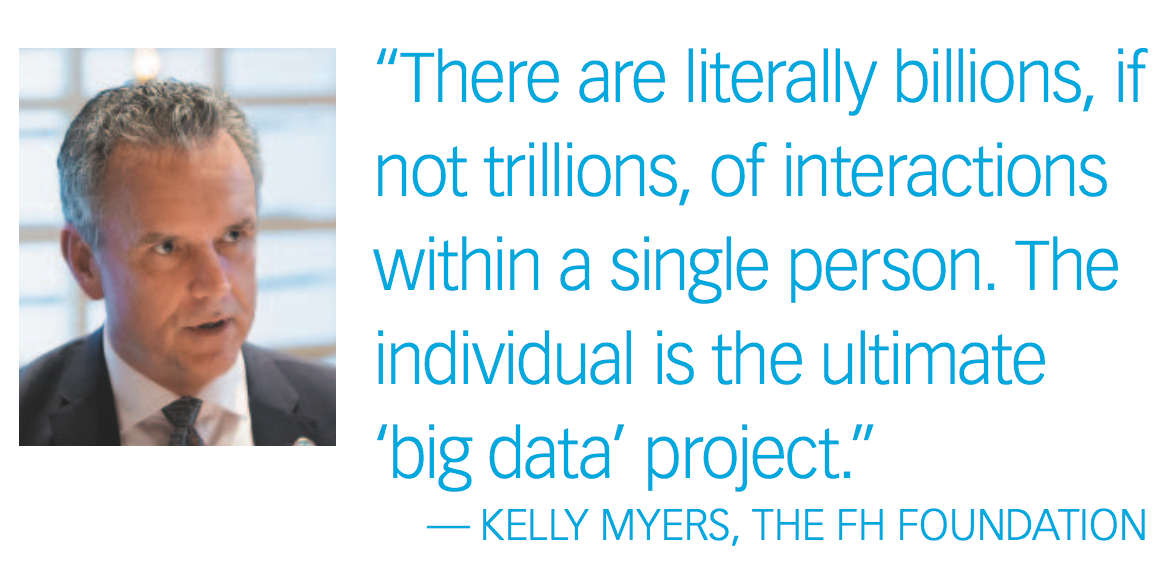
within a single person. The individual is the ultimate “big data” project.
Saitta: Cognitive computing is another emerging force. We can give a computer the capability to process information like any human would-in other words, endowing the computer with artificial intelligence (AI), as IBM Watson and Google are doing. As AI gradually comes to life within these large institutions, we have to pay attention to it. And then there is the arrival of ubiquitous broadband. Information will literally be everywhere and accessible without switching between different platforms or channels.
Myers: These technology changes will also be available at lower cost. Seven years ago, in my last start-up operation, we had to spend $300,000 on a server room filled with $500,000 worth of equipment. Today, the Foundation’s monthly cloud computing bill is $175, with infinitely more computing power at hand than we had seven years ago. This is the democratization of information technology. Money or even expertise is no barrier. Where we still have to get to is democratizing the insights from the bounty of data. And that’s going to take time along with new skill sets.
Looney: Given these trends, how ready is the CIO to respond? What implications do they hold for the future of this role in the c-suite?
Serhan: The CEO is going to expect that the CIO will respond to these signals and master them rather than demanding the recruitment of still more staff to manage the change. This is not entirely a headcount problem. Instead, what counts is the dynamics of the c-suite executive team in how it interacts as a group. To me, it represents an opportunity for the CIO to make the position a core part of the company’s value proposition to customers. It can certify once and for all that the CIO is a strategic player, not a back-office service vendor. Part of the line business operation, not a staff function.
With all the focus today on “beyond the pill,” this is the chance to prove that the CIO has the insights and the influencing skills to push the company to that destination.
In our business of executive recruitment, we also see the CIO’s future role attracting much more interest at the Board of Directors level. Biopharma companies are asking us to help in the recruitment of non-executive directors with experience in managing consumer information flows in other industries. The idea is to bring that knowledge into this industry. Boards can help the process by delivering the message to the c-suite that the culture within biopharma has to change-it’s time to embrace the data.
Pickett: Cultural change driven from the top is critical. I’ve learned this from Mark Timney, the first outsider in Purdue’s 60-year history to assume the CEO post. Analytics is one of the core competencies he has identified as part of that culture: facts, data and evidence will be the basis of all Purdue decisions going forward.
A few years ago, I created an internal data analytics work team and sought members from all parts of the business. No one showed up. Today, due to Timney’s personal commitment to this topic, these meetings have expanded to ownership by the business and are well attended.
Looney: One final point about the future-is drug regulation likely to emerge as an obstacle to realizing the business potential from big data? I ask this because regulation is cited as an impediment to innovation in other aspects of the biopharma business model.
Louzan: I don’t see regulation as a drag on our ability to innovate in improving the analytical content of our decision-making. In some ways, it’s already baked in due to the ingrained perception that regulation drives up our development costs. In fact, I believe competitiveness within the industry is a far more serious obstacle to innovation than regulatory pressure.
I recently attended a data and analytics conference where the topic-“how do you share data?”-came up in discussion. It felt like half the room was having a heart attack because of the competitive nature of the industry. However, I see a positive evolution with an increased number of initiatives to be able to share data. I believe this is the right thing to do for our patients.
Pickett: My experience is the FDA is open to partnering with companies to use data in new ways and to think about the clinical implications of evolving technologies.
Myers: Regulators do have an obligation to be as consistent and clear as possible. There are still many ambiguities around who actually owns the data and what should be considered clinical decision support. More clarity would help.
William Looney is Pharm Exec’s Editor-in-Chief. He can be reached at william.looney@ubm.com
